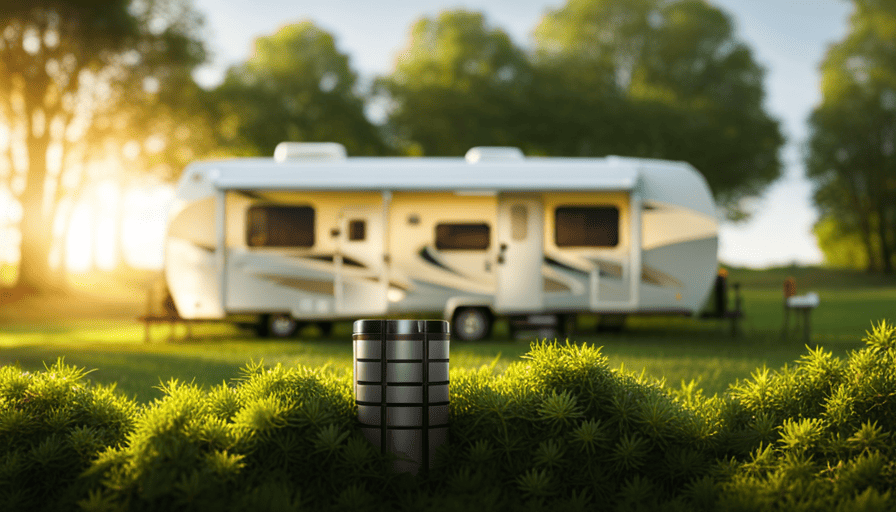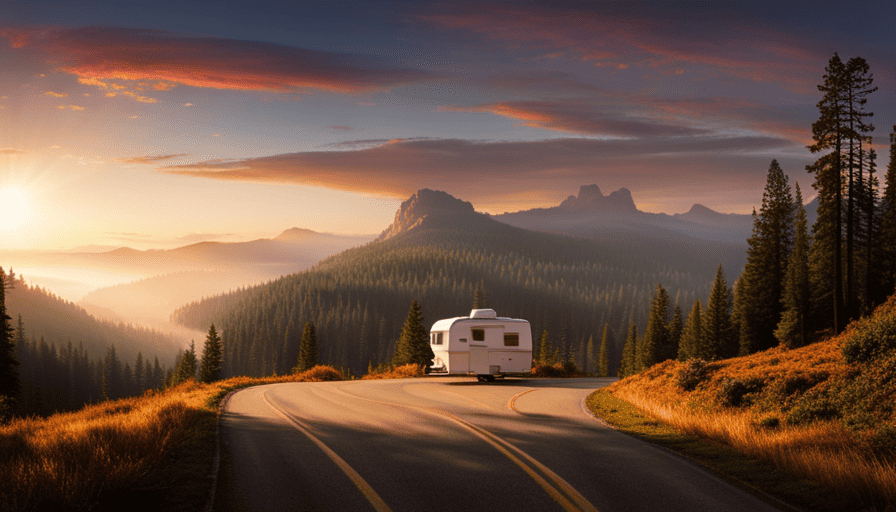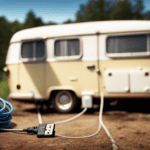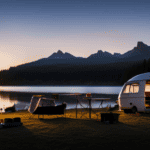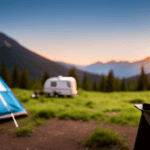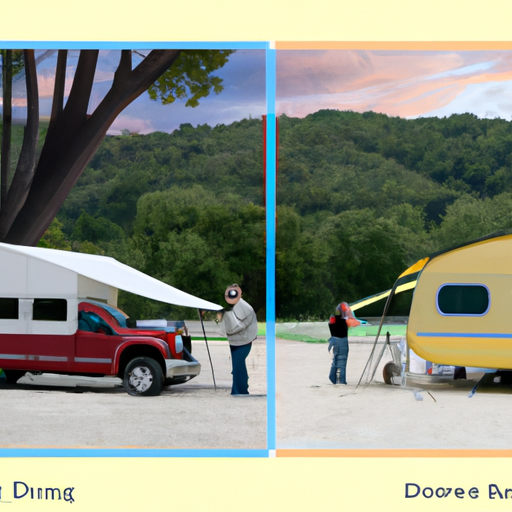Similar to a camper’s core, the battery fuels all dimensions of our adventurous escapades. It’s the vital force that maintains the illumination, ensures the coolness of the refrigerator, and keeps our gadgets powered up. However, akin to any energy source, the lifespan of camper batteries is finite.
So, how long do camper batteries last? In this article, I will delve into the world of camper batteries, exploring the different types available, the factors that affect their lifespan, and the signs of deterioration to watch out for. I will also provide valuable tips on how to extend the lifespan of your battery, alternative power sources to consider, and essential safety precautions.
Whether you are a seasoned camper or new to the world of RVing, understanding the lifespan of your camper battery is crucial for a smooth and enjoyable journey. So, let’s dive in and unravel the mysteries of camper batteries together.
Key Takeaways
- Camper batteries have a limited lifespan, typically lasting 3 to 5 years for lead-acid batteries and up to 10 years or more for lithium-ion batteries.
- Proper storage in a cool and dry place, regular inspection and cleaning of battery terminals, and avoiding deep discharges can help extend the lifespan of camper batteries.
- Factors such as temperature, usage patterns, and charging practices can affect the lifespan of camper batteries.
- It is important to choose the right replacement battery based on capacity and voltage, and to consider professional installation or a DIY approach for battery replacement.
Types of Camper Batteries
When it comes to camper batteries, there are three main types: lead-acid, lithium-ion, and AGM.
Each type has its own unique characteristics and benefits.
Lead-acid batteries are the most common type used in campers. They’re affordable and reliable, but they require regular maintenance to ensure optimal performance. This includes checking the water levels and cleaning the terminals. Lead-acid batteries also have a limited capacity compared to other types, which means they may not last as long between charges.
On the other hand, lithium-ion batteries are becoming increasingly popular in the camper community. They have a much higher capacity than lead-acid batteries, which means they can last longer between charges. They’re also lightweight and require no maintenance. However, they’re more expensive upfront.
AGM (absorbent glass mat) batteries are a hybrid between lead-acid and lithium-ion batteries. They have a higher capacity than lead-acid batteries but aren’t as expensive as lithium-ion batteries. They also require minimal maintenance.
Factors affecting battery lifespan include temperature, usage patterns, and charging practices. It’s important to keep your camper battery in a cool, dry place to prolong its life. Additionally, regularly cycling the battery and avoiding overcharging can help extend its lifespan.
Factors Affecting Battery Lifespan
As you journey with your camper, various factors can symbolically drain the life force from your battery. One crucial factor that affects the lifespan of your camper battery is battery storage. Improper storage can lead to a shortened battery life. It’s essential to store your battery in a cool, dry place to maintain its performance. Extreme temperatures can have a detrimental impact on battery health. High temperatures can cause the battery to overheat and reduce its capacity, while freezing temperatures can damage the battery’s internal components.
Another factor that influences battery lifespan is the impact of weather. Exposure to harsh weather conditions such as extreme heat, cold, or humidity can accelerate wear and tear on the battery. It’s recommended to shield your battery from direct sunlight and extreme temperatures whenever possible.
Transitioning into the subsequent section about the average lifespan of camper batteries, it’s important to note that these factors can significantly affect how long your battery lasts. By understanding and addressing these factors, you can extend the lifespan of your camper battery and ensure a reliable power source for your adventures.
Average Lifespan of Camper Batteries
Protecting your battery from harsh weather conditions and storing it properly in a cool, dry place is crucial for ensuring a reliable power source throughout your camper adventures. Proper camper battery maintenance is essential for maximizing its lifespan.
On average, a well-maintained lead-acid battery can last anywhere from 3 to 5 years, while lithium batteries can last up to 10 years or more.
To prolong the lifespan of your camper battery, here are some important tips to keep in mind:
- Regularly inspect and clean the battery terminals to prevent corrosion.
- Avoid completely discharging the battery, as this can cause irreversible damage.
- Charge your battery fully before storing it for an extended period.
- Consider investing in a battery maintenance device to keep the charge level optimal.
- Opt for lithium batteries, which have several advantages such as longer lifespan, lighter weight, and faster charging capabilities.
By following these maintenance practices and considering the benefits of lithium batteries, you can significantly extend the lifespan of your camper battery. However, it’s important to be aware of the signs of battery deterioration to avoid unexpected power failures during your trips.
Signs of Battery Deterioration
When it comes to camper batteries, there are a few signs that indicate deterioration. One common sign is decreased capacity, meaning that the battery isn’t able to hold as much charge as it used to.
Another sign is longer charging times, where it takes longer for the battery to reach a full charge.
Lastly, a swollen or bulging battery is another clear indication of deterioration and should be addressed immediately.
Decreased Capacity
Imagine you’re out in the middle of nowhere, surrounded by nature, when suddenly, the battery in your camper starts showing signs of decreased capacity. It can be a frustrating situation, but understanding battery maintenance and maximizing battery life can help prevent this issue.
Regularly checking and cleaning the battery terminals, ensuring proper ventilation, and avoiding overcharging are all important steps in prolonging the life of your camper battery. However, even with proper maintenance, batteries will naturally deteriorate over time.
Signs of decreased capacity include shorter battery life, slower cranking of the engine, and dimming of lights. When you notice these signs, it’s crucial to address the issue promptly. Longer charging times may be necessary to compensate for the decreased capacity and ensure your battery remains functional during your camping adventures.
Longer Charging Times
To make sure your battery remains fully charged, you’ll need to adjust your charging times accordingly. When it comes to longer charging times, there are a few factors to consider, especially if you plan on long-term storage or using solar power. Both of these scenarios require a different approach to charging your camper battery.
First, let’s talk about long-term storage. If you won’t be using your camper for an extended period, it’s crucial to keep the battery charged. A good rule of thumb is to charge it every three months to prevent capacity loss. However, if you have a solar power system installed, you can rely on it to keep your battery charged during storage.
Now, let’s explore the impact of solar power on charging times. Solar panels are an excellent option for off-grid camping as they can charge your battery during the day. However, keep in mind that solar charging is slower than using a traditional RV charger. It may take longer to reach a full charge, especially on cloudy days.
Understanding the impact of long-term storage and solar power on charging times is essential for maintaining your camper battery’s longevity. Now, let’s delve into the next section and discuss signs of a swollen or bulging battery.
Swollen or Bulging Battery
A swollen or bulging battery is like a ticking time bomb, ready to explode at any moment, putting your safety at risk. Battery swelling or bulging can occur due to various reasons such as overcharging, excessive heat, or manufacturing defects. It’s crucial to address this issue promptly to prevent any potential hazards. Here are three signs that indicate your camper battery might be swelling or bulging:
-
Bulging appearance: If your battery has a visibly rounded or distorted shape, it’s a clear indication of swelling.
-
Increased temperature: A swollen battery tends to generate more heat than usual. If you notice your battery becoming unusually hot during charging or use, it may be a sign of swelling.
-
Leaking electrolyte: Swelling batteries often develop leaks, leading to the appearance of a sticky residue around the battery terminals.
Identifying these signs and taking immediate action, such as replacing the battery, can help prevent accidents and extend the lifespan of your camper battery.
Extending Battery Lifespan
You can significantly extend your camper battery’s lifespan by implementing a few simple strategies. One of the key factors in extending battery life is maximizing battery performance. To do this, it’s important to avoid deep discharges, as they can greatly reduce the overall lifespan of your battery.
Instead, try to keep your battery charged above 50% whenever possible. This can be achieved by using a battery monitor or voltage meter to keep track of your battery’s charge level.
Additionally, it’s important to avoid overcharging your battery. Overcharging can lead to excessive heat buildup, which can damage the battery’s internal components. To prevent overcharging, consider investing in a smart charger that automatically adjusts the charging rate based on the battery’s needs.
Another way to extend your battery’s lifespan is to minimize the use of high-power appliances when running on battery power. These appliances can drain the battery quickly and put additional strain on its components. Instead, try to use low-power alternatives or limit the use of high-power appliances to when you have access to shore power.
By following these strategies, you can greatly extend the lifespan of your camper battery and maximize its performance. Taking care of your battery and ensuring it’s properly maintained is crucial to its longevity.
In the next section, we’ll discuss some important tips for battery care and maintenance.
Battery Care and Maintenance
Take good care of your battery by regularly inspecting its connections and cleaning any corrosion that may have built up. Proper battery care and maintenance are essential for maximizing battery performance and extending its lifespan.
Here are three key steps you can take to ensure your battery stays in top condition:
-
Battery Storage: When storing your camper battery for an extended period, it’s important to keep it in a cool and dry place. Extreme temperatures can negatively impact battery performance and lead to faster degradation. Consider using a battery maintainer or trickle charger to keep the battery charged and prevent it from fully discharging during storage.
-
Regular Charging: Regularly charging your battery is crucial to maintain its optimal performance. If your camper isn’t in use, make sure to charge the battery at least once every month. This helps prevent sulfation, a process in which lead sulfate crystals form on the battery plates and reduce its capacity.
-
Proper Discharging: Avoid fully discharging your battery whenever possible. Deep discharges can strain the battery and reduce its overall lifespan. Instead, aim to keep the battery above 50% charge to maximize its longevity.
By following these battery care and maintenance practices, you can effectively maximize battery performance and extend its lifespan. However, if your battery’s beyond repair and replacement is necessary, let’s explore the next section on replacing camper batteries.
Replacing Camper Batteries
When it comes to replacing camper batteries, there are a few important factors to consider.
First, it’s crucial to properly recycle or dispose of the old batteries to minimize environmental impact.
Second, choosing the right replacement battery is essential for optimal performance and longevity.
Finally, deciding between professional installation or a DIY approach depends on your level of expertise and comfort with electrical systems.
By addressing these key points, you can ensure a smooth and successful battery replacement process for your camper.
Recycling and Disposing of Old Batteries
Recycling and disposing of old batteries can be a sustainable way to ensure the longevity of our camper batteries. By properly recycling our old batteries, we can reduce the environmental impact of hazardous materials ending up in landfills. Here are five important things to know about recycling and disposing of old batteries:
- Look for recycling centers or drop-off locations in your area that accept batteries.
- Follow any specific guidelines for battery recycling provided by the recycling center.
- Consider participating in battery recycling programs offered by manufacturers or retailers.
- Be aware of the potential environmental hazards associated with improper battery disposal.
- Educate yourself on the different recycling methods available for various types of batteries.
Taking the time to recycle and dispose of old batteries responsibly will not only help protect the environment but also ensure that our camper batteries continue to perform at their best.
Now let’s move on to the next section, where we’ll discuss choosing the right replacement battery.
Choosing the Right Replacement Battery
To ensure optimal performance, selecting the appropriate replacement battery for your camper requires careful consideration and familiarity with the specific power requirements of your vehicle. One important factor to consider is battery capacity, which refers to the amount of energy the battery can store. This is measured in ampere-hours (Ah) and determines how long the battery will last before needing to be recharged.
Another crucial factor is battery voltage, which indicates the electrical potential difference between the positive and negative terminals. The most common voltages for camper batteries are 12V and 6V. It’s essential to choose a battery with the correct capacity and voltage to ensure compatibility with your camper’s electrical system.
By selecting the right replacement battery, you can maximize the lifespan and efficiency of your camper’s power supply.
Transitioning into the next section, it’s important to consider whether to opt for professional installation or a DIY approach.
Professional Installation vs. DIY
For optimal results, you should consider whether it’s best to have a professional install your replacement battery or if you’re up for a DIY approach.
If you choose to go the professional route, you can benefit from their expertise and ensure that the battery is installed correctly. However, this option may come with a higher cost.
On the other hand, a DIY installation can save you money but requires a certain level of technical knowledge and skill. If you’re confident in your abilities and have experience working with electrical systems, this may be a viable option for you. Just remember to follow safety precautions and consult the manufacturer’s instructions.
Now, let’s move on to exploring alternative power sources for campers.
Alternative Power Sources for Campers
Did you know that there’s a range of alternative power sources available for campers, so you can enjoy your outdoor adventures without worrying about draining your camper battery? When it comes to powering your camper, solar power panels and portable generators are two popular options to consider.
Solar power panels are a great eco-friendly choice for campers. They harness the energy from the sun and convert it into electricity to charge your camper battery. These panels are typically installed on the roof of your camper and can provide a steady source of power during daylight hours. They are low maintenance and can be a cost-effective long-term solution.
On the other hand, portable generators offer flexibility and convenience. They run on gasoline or propane and can be easily transported and used wherever you go. These generators are perfect for campers who need a quick and reliable power source. However, it’s important to note that they require fuel and regular maintenance.
Here’s a comparison of solar power panels and portable generators:
| Solar Power Panels | Portable Generators |
|---|---|
| Eco-friendly | Convenient |
| Low maintenance | Requires fuel |
| Long-term solution | Regular maintenance required |
By considering alternative power sources like solar power panels and portable generators, you can extend the lifespan of your camper battery and ensure a continuous power supply during your camping trips. In the next section, we will discuss essential battery safety tips to keep in mind.
Essential Battery Safety Tips
After discussing alternative power sources for campers, let’s dive into some essential battery safety tips. As an avid camper, I’ve learned the importance of properly maintaining and using camper batteries to ensure a reliable power source during my adventures.
To begin with, it’s crucial to understand the different battery charging techniques available, such as trickle charging and smart charging, to maximize their lifespan. Additionally, always keep an eye on battery voltage levels and avoid deep discharges, as this can significantly decrease their overall capacity.
Common battery problems can arise if you neglect regular maintenance. One key tip is to regularly inspect and clean the battery terminals to prevent corrosion, which can hinder proper electrical connections. It’s also important to avoid overcharging or undercharging the battery, as this can lead to irreversible damage.
To summarize, here are four essential battery safety tips to keep in mind:
- Utilize proper battery charging techniques, such as trickle charging or smart charging.nn2. Monitor battery voltage levels and avoid deep discharges.nn3. Regularly inspect and clean battery terminals to prevent corrosion.nn4. Avoid overcharging or undercharging the battery.
Now, let’s address some frequently asked questions about camper batteries.
Frequently Asked Questions about Camper Batteries
If you’re wondering about some common concerns regarding the lifespan and maintenance of your camper batteries, let’s address those frequently asked questions.
When it comes to camper batteries, one of the most important things to consider is the battery charging method. The two main methods are the built-in charger and a portable charger. The built-in charger allows you to charge your batteries while connected to shore power or running your generator. On the other hand, a portable charger gives you the flexibility to charge your batteries even when you’re not near a power source.
When it comes to troubleshooting common battery issues, there are a few things you can check. First, make sure that your battery terminals are clean and free of corrosion. Corrosion can prevent a good connection and affect the performance of your batteries. Next, check the water levels in your batteries. Low water levels can lead to decreased battery life and performance. Finally, if you’re experiencing issues with your batteries not holding a charge or not providing enough power, it may be time to replace them.
Understanding the different battery charging methods and troubleshooting common battery issues can help ensure the longevity and proper maintenance of your camper batteries. By following these tips, you can maximize the lifespan of your batteries and enjoy your camping trips without worrying about power supply.
Frequently Asked Questions
What are the different types of camper batteries available in the market?
There are several different types of camper batteries available in the market. The most common types include lead-acid batteries, lithium-ion batteries, and AGM (absorbent glass mat) batteries.
Each type has its own pros and cons. Lead-acid batteries are affordable but require regular maintenance. Lithium-ion batteries are lightweight and have a longer lifespan but are more expensive. AGM batteries are maintenance-free and can handle deep discharges.
The best type of battery for different camping needs depends on factors such as power requirements and budget.
How do extreme temperatures affect the lifespan of camper batteries?
Extreme temperatures can be like the wild, untamed elements that test the strength of camper batteries. Excessive heat can accelerate chemical reactions, causing batteries to lose capacity faster. On the other hand, extremely cold temperatures can slow down the chemical reactions, making batteries less efficient.
To protect your camper battery, store it in a temperature-controlled environment when not in use. Additionally, using insulation or a battery blanket can help regulate its temperature during extreme weather conditions.
Can I use solar panels as an alternative power source for my camper battery?
Yes, solar panels can be used as an alternative power source for camper batteries. They have several benefits, such as providing a clean and renewable energy source, reducing the need for generator usage, and extending the battery life. Solar panels harness the sun’s energy to charge and maintain the batteries, making them ideal for off-grid camping. Additionally, they’re low maintenance and can be easily installed on the roof or mounted on a portable stand.
Are there any specific signs or symptoms that indicate my camper battery needs to be replaced?
There are several warning signs and common problems that may indicate the need to replace your camper battery. Some warning signs include a slow engine start, dimming lights, and a battery that frequently needs to be jump-started.
Common problems can include a battery that no longer holds a charge, excessive corrosion on the terminals, or a battery that’s more than three years old.
If you experience any of these issues, it’s likely time to replace your camper battery.
Is it possible to extend the lifespan of my camper battery by using a battery tender or charger?
Using a battery tender or charger can significantly extend the lifespan of your camper battery. In fact, studies have shown that properly maintaining your battery can double its lifespan. Regularly charging your battery and keeping it at the recommended voltage levels are key to maximizing its longevity.
Additionally, following best practices such as avoiding overcharging and keeping the battery clean and well-ventilated can further enhance its performance and durability.
Can I Use a Camper Loan to Purchase a New Battery?
If you are wondering whether you can use a camper loan to purchase a new battery, it’s important to understand the camper loan duration options available to you. While a camper loan can usually be used for purchasing a camper or RV, it may not be ideal for smaller purchases like a battery. Consider exploring alternative financing options or savings to cover the cost of a new battery.
Conclusion
In conclusion, when it comes to the lifespan of camper batteries, it’s important to remember that even the mightiest of batteries eventually fade like a setting sun. However, with proper care and attention, you can make your batteries last longer than a marathon runner’s endurance.
Keep a close eye on any signs of deterioration and take steps to extend their lifespan, like giving them a well-deserved break and utilizing alternative power sources. With these tips in mind, you’ll be able to power your adventures with a battery that’s as reliable as the North Star.

